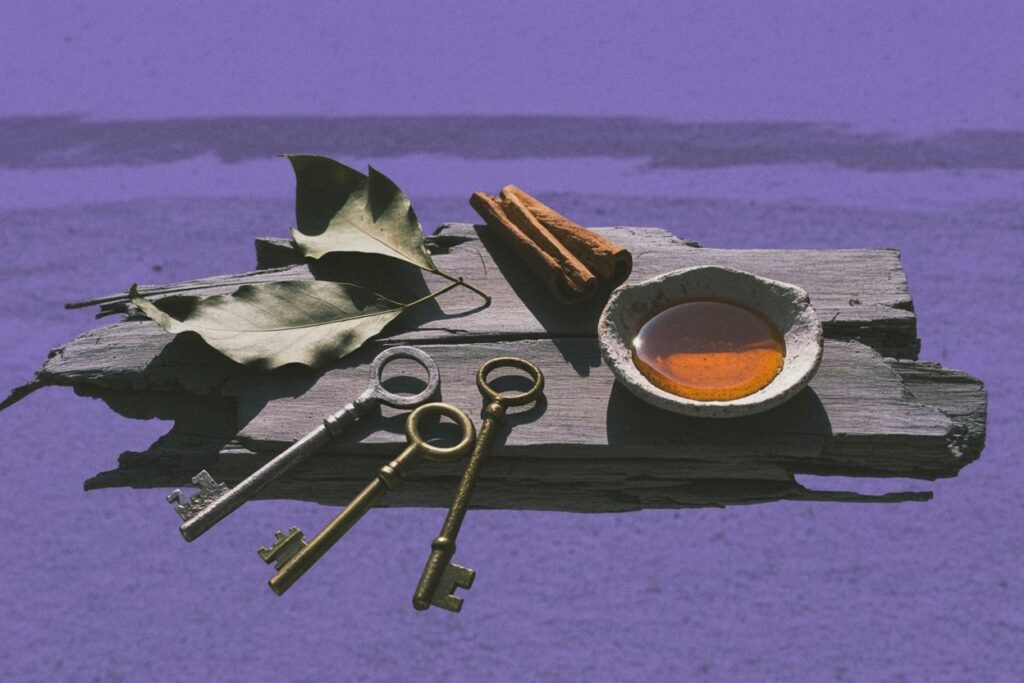Herbal Offerings for Hecate: Sacred Plants to Honor the Goddess
Please note that posts on this site may contain affiliate links
Honoring Hecate with sacred plants is a deeply meaningful way to connect with this ancient and powerful goddess. Known as the goddess of witchcraft, crossroads, and the underworld, Hecate holds a unique place in both ancient mythology and modern spiritual practices. By making herbal offerings, you can strengthen your bond with her and incorporate her energy into your life. But which herbs are best for honoring Hecate, and how do you use them in your rituals?
Exploring the sacred plants tied to Hecate not only deepens your spiritual connection but also introduces you to the rich world of herbal magic. Whether you’re new to honoring this goddess or have been working with her for years, understanding the plants associated with her can help bring your practice to the next level. Let’s delve into the herbs that are sacred to Hecate and discover how they can be used to honor her in powerful ways.
Why It Matters to You
Herbal offerings to Hecate are not just about ancient traditions; they are a bridge between the mystical and the everyday. For those who feel drawn to Hecate, creating sacred offerings with plants can be a deeply personal way to connect with her. Each herb holds specific symbolism and energy that can align with the goddess’s multifaceted nature, from her associations with protection and healing to her roles in the underworld and at crossroads.
Using sacred plants in rituals allows you to bring Hecate’s energy into your life. Whether you seek guidance at a crossroads, protection in difficult times, or clarity in your spiritual journey, these herbs serve as tangible tools to make your intentions clear. For modern practitioners, they provide a link to ancient practices that are still relevant today.
Understanding why these herbs matter can inspire you to approach your offerings with respect and intention. When you create these sacred moments, it’s not just about honoring Hecate—it’s about grounding yourself in a tradition that helps you grow spiritually and emotionally. This practice creates a deeper sense of connection, not only to Hecate but to the natural world and your own inner power.

Understanding Hecate and Her Connection to Plants
Who is Hecate?
Hecate is a goddess steeped in mystery and power. Revered in ancient Greece and beyond, she is known as the goddess of witchcraft, crossroads, and the underworld. Her presence is multifaceted, embodying both light and dark aspects of life. She is a guardian of transitions, a protector of the liminal spaces where one phase of life ends and another begins.
In mythology, Hecate is often depicted as a triple goddess, symbolizing her dominion over the realms of earth, sea, and sky. She is a guide for those navigating change, offering protection to travelers and those embarking on spiritual journeys. Hecate is also a teacher, sharing her knowledge of magic, divination, and herbalism with her followers. This role as a mentor is particularly significant, as it ties her closely to the natural world and the potent energies found in plants.
Hecate’s connection to plants is rooted in her chthonic nature, associating her with the cycles of life, death, and rebirth. Many of the herbs sacred to her are those that grow in shadowy or liminal spaces—poisonous, healing, or both—symbolizing her dual nature as a nurturer and a destroyer.
Why Plants are Sacred to Hecate
Plants have long been sacred to Hecate because they embody the transformative energy she represents. From poisonous plants like belladonna and hemlock to protective herbs like rosemary and sage, each plant holds unique properties that align with her roles in magic and healing. These plants are not just offerings—they are tools for invoking her power and creating a tangible connection to her essence.
In ancient times, practitioners used these herbs to honor Hecate in rituals and ceremonies. Offerings of garlic, a traditional chthonic herb, were left at crossroads to seek her guidance. Poisonous plants like aconite were used in protective spells to banish negative energies, reflecting Hecate’s role as a guardian.
Herbs associated with purification and protection, such as thyme and mugwort, were burned as incense to cleanse sacred spaces and invite Hecate’s presence. These practices emphasized her ability to bridge the seen and unseen, guiding practitioners in both physical and spiritual realms.
Hecate’s sacred plants are more than magical tools—they are symbols of her teachings. They remind us of the delicate balance between life and death, creation and destruction, and the power that comes from embracing both. By working with these herbs, practitioners align themselves with her wisdom and guidance, creating a harmonious connection to her energy and the natural world.

Sacred Plants Associated with Hecate
Poisonous Plants and Their Symbolism
Hecate is strongly associated with poisonous plants, which reflect her chthonic nature and her dominion over life, death, and transformation. Among these, aconite, belladonna, and hemlock stand out as particularly significant.
Aconite, also known as wolfsbane, is a potent herb that embodies protection and transformation. It was historically used in rituals to ward off evil spirits and protect sacred spaces.
However, its toxicity requires careful handling—always wear gloves when working with aconite, and avoid ingesting or inhaling it in any form. Aconite’s mystical properties make it a powerful offering to Hecate, symbolizing strength and the courage to face life’s crossroads.
Belladonna, or deadly nightshade, is a plant deeply tied to the mysteries of the underworld. Its dark, glossy berries and hauntingly beautiful flowers reflect Hecate’s dual nature as a goddess of both life and death.
Belladonna has been used in magical practices for visions and connection to the spiritual realm, though its toxicity means it must be used symbolically rather than physically. For example, dried belladonna leaves can be placed on an altar to honor Hecate without risk.
Hemlock is another sacred herb associated with Hecate, often symbolizing transitions and endings. Ancient practitioners used it in rituals to invoke transformative energies, making it a fitting herb for those seeking Hecate’s guidance through difficult life changes.
Like the others, hemlock is highly toxic and should never be ingested. Instead, incorporate it into spells or offerings in a non-contact way, such as placing a sprig in a sealed jar on your altar.

Herbs for Purification and Protection
Purification and protection are central to Hecate’s energy, and herbs like sage, thyme, and rosemary are excellent tools for these purposes. These plants are safer to handle and widely available, making them ideal for both beginners and experienced practitioners.
Sage is a well-known herb for cleansing and banishing negativity. Burning sage in a ritual space helps to clear out residual energies and create a purified environment for honoring Hecate. For a more focused connection to the goddess, blend sage with other sacred herbs like lavender or rosemary.
Thyme is another herb associated with protection and courage. It can be used to create protective charms or sachets. Adding thyme to an herbal blend for a ritual bath invokes Hecate’s protective energy, helping you feel fortified as you navigate challenges.
Rosemary, known for its association with remembrance and purification, is a versatile herb in Hecate’s sacred repertoire. Use rosemary in incense blends to cleanse your space or as a symbolic offering on her altar. Its needle-like leaves and woody aroma evoke the enduring strength and clarity that Hecate provides.
Chthonic Herbs and Their Ritual Uses
Hecate’s connection to the underworld is reflected in her association with chthonic herbs like garlic, lavender, and mints. These plants are particularly significant in rituals that emphasize her role as a guide to the unseen and protector of liminal spaces.
Garlic has long been associated with Hecate and other chthonic deities. Its pungent aroma and protective properties make it a staple offering in rituals to honor her. Place cloves of garlic at crossroads or use them in protective spells to invite her guidance and ward off negativity.
Lavender, with its calming scent and deep purple hue, bridges the gap between the physical and spiritual realms. Lavender is often burned as incense or placed in sachets to invite dreams and visions under Hecate’s watchful eye. Its soothing energy makes it a perfect herb for those seeking peace and clarity in their spiritual journey.
Mints, including peppermint and spearmint, are cooling and cleansing herbs that resonate with Hecate’s underworld aspects. Their refreshing scent and properties make them ideal for clearing away stagnant energies. Brew a tea with mint leaves to invite her energy into your practice or use fresh sprigs in offerings to represent renewal and rebirth.
Practical Ritual Applications
Incorporating these sacred plants into your practice can be as simple or elaborate as you like. Use rosemary and sage to prepare your space before a ritual, or create an herbal blend with lavender and mint to focus your intentions. Poisonous plants like belladonna and aconite can be used symbolically in rituals to honor Hecate’s transformative powers, reminding you of her guidance through life’s transitions.
These herbs not only deepen your connection to Hecate but also empower your magical practice, allowing you to draw upon her wisdom and protection in tangible ways.

Practical Rituals and Offerings
How to Create an Herbal Altar for Hecate
Creating an herbal altar for Hecate is a meaningful way to honor her and invite her presence into your life. Altars are sacred spaces that allow you to focus your intentions and show reverence to the goddess. Here’s a step-by-step guide to setting up an altar for Hecate with herbal offerings:
- Choose a Dedicated Space
Select a quiet, undisturbed area in your home or garden. This can be a small table, a shelf, or even a spot on the ground. Hecate’s altars are often placed at crossroads or liminal spaces, symbolizing her connection to transitions. - Prepare the Foundation
Cleanse the space with sage, rosemary, or thyme to clear away stagnant energies. You can burn the herbs as incense or sprinkle a herbal-infused water over the area. - Select Your Offerings
Include sacred herbs like garlic, lavender, or rosemary. Poisonous plants like aconite or belladonna can be added symbolically but must be handled with care. Arrange these herbs in small bundles, jars, or bowls. - Add Symbolic Items
Incorporate items that resonate with Hecate, such as black candles (representing protection and magic) and white candles (symbolizing light and guidance). Keys, small cauldrons, and images or statues of Hecate can further personalize the space. - Enhance the Atmosphere
Place offerings of food like bread, honey, or eggs alongside the herbs. Add elements like moonstones, crystals, or coins to reflect her connection to the moon and the underworld. - Dedicate the Space
Light a candle and speak a prayer or invocation to dedicate the altar to Hecate. Express your intentions and invite her to bless the space.
Ritual Ideas for Beginners and Advanced Practitioners
Beginner-Friendly Ritual: Herbal Incense Blends
Crafting a simple herbal incense blend is a great way for beginners to honor Hecate. Combine dried lavender, rosemary, and thyme in a small bowl. Burn the mixture on a charcoal disk and let the smoke carry your intentions to her. While the incense burns, speak your request or gratitude aloud.
Advanced Ritual: Crafting a Talisman or Herbal Oil
For advanced practitioners, creating a talisman imbued with Hecate’s energy can be a powerful offering. Use a small pouch filled with her sacred herbs, like mugwort, garlic, and lavender. Add a key or other symbolic item to represent her guidance. Carry the talisman with you or place it on her altar as an offering.
Alternatively, you can craft an herbal oil dedicated to Hecate. Infuse olive oil with garlic, rosemary, and lavender by placing the herbs in a jar, covering them with oil, and leaving it to steep in moonlight for several weeks. Use this oil to anoint candles, tools, or yourself during rituals.
Whether you’re a beginner or an experienced practitioner, these rituals help you create a meaningful connection with Hecate. By incorporating her sacred herbs into your practice, you honor her presence and invite her wisdom into your life.
Insights, Tips, and Warnings
Common Mistakes to Avoid
When working with sacred plants for Hecate, it’s important to avoid common pitfalls that can hinder your practice or create unintended consequences. One major mistake is overlooking plant safety. Many herbs associated with Hecate, such as belladonna and hemlock, are highly toxic. Always handle these with gloves, keep them out of reach of children and pets, and never ingest them unless you are absolutely certain they are safe.
Cultural sensitivity is another key consideration. Hecate’s worship is rooted in ancient Greek traditions, and while adapting practices is fine, it’s important to approach her rituals with respect for their origins. Avoid appropriating elements from unrelated cultures without understanding their meaning.
Lastly, incorrect correspondences can dilute your practice. Research the symbolism and uses of each herb to ensure you’re aligning with Hecate’s energy. For example, using herbs for prosperity when seeking protection might not yield the results you want.
Beginner-Friendly Tips
For those new to honoring Hecate with herbs, start by sourcing your plants safely. Look for organic, pesticide-free options at local markets or online herb shops. When harvesting your own, ensure the plant is correctly identified to avoid toxic lookalikes.
Growing herbs like lavender, rosemary, and thyme is an excellent way to stay connected to Hecate year-round. These plants are easy to cultivate in small pots or gardens and can be used fresh or dried in rituals.
How to Incorporate Into Daily Life
Integrating Hecate’s sacred plants into your daily routine can be simple and meaningful. Use rosemary or thyme in your cooking to invoke her protection. Light lavender incense in the evening to invite her calming presence. Create small sachets with dried herbs like mint and garlic to carry with you as a protective charm.
These everyday practices keep Hecate’s energy close and reinforce your connection to her, even outside of formal rituals. Whether through a cup of herbal tea or a sprig of rosemary on your altar, these small gestures can have a profound impact on your spiritual journey.
FAQs About Herbal Offerings for Hecate
What are the safest herbs to use for Hecate?
If you’re concerned about handling poisonous plants, there are plenty of safe herbs associated with Hecate. Lavender, rosemary, thyme, sage, and mint are all excellent choices. These herbs are widely available, easy to work with, and versatile in their magical and practical uses. They can be used in offerings, burned as incense, or incorporated into spells and rituals with minimal risk.
Can I honor Hecate without poisonous plants?
Absolutely! While poisonous plants like belladonna and hemlock are traditionally associated with Hecate, they are not required to honor her. Many practitioners use safe and symbolic herbs like garlic, lavender, and rosemary. These herbs still hold deep connections to her energy and can be incorporated into offerings, altars, and rituals without the risks associated with toxic plants.
How do I dispose of offerings respectfully?
To dispose of offerings, choose a method that feels sacred and environmentally mindful. Bury organic materials, such as herbs, in the earth, preferably near a crossroads or a tree. Alternatively, you can burn them and scatter the ashes in a natural space. Always express gratitude to Hecate as you complete the ritual.
Can I grow these plants at home?
Yes, many of Hecate’s sacred herbs can be grown at home! Lavender, rosemary, thyme, garlic, and mint thrive in small gardens or pots. Growing these plants allows you to build a personal connection to them, ensuring they are fresh, organic, and energetically aligned for your rituals. Plus, caring for the plants can be a devotional act in itself.

Full Moon Magic with Hekate: An Exclusive Guide
Unlock the transformative power of Hekate during the full moon for just $4.99 with ‘Working With Hekate During The Full Moon‘—awaken your spirit, harness new opportunities, and connect deeply with the goddess of witchcraft.
What Hecate Teaches with Seven Stones: Tourmaline, Obsidian, Moonstone, and Threshold Boundaries
You’re standing at a three-way crossroads at dusk, holding a piece of black tourmaline. The…
21 Hekate Inspired Makeup Looks (Witchy Makeup)
Hekate, the ancient Greek goddess of witchcraft, crossroads, and the night, brings fierce goddess energy…
Hekate And The Summer: Life, Death And Liminality Under The Scorching Sun
Hekate belongs to summer because she is the goddess of thresholds, and the summer solstice…
Hekate’s Sacred Animals: Symbolic Meanings of Dogs, Crows, and Snakes
Hekate’s sacred animals are keys to understanding this ancient goddess of crossroads, witchcraft, and liminal…
How to Honor Hekate in Your Daily Witchcraft Practice
You honor Hekate daily by creating an altar with keys and candles, speaking prayers to…
Simple Tricks to Working with Hekate During the Full Moon
Hekate was originally a chthonic deity. A Titaness who predated the Olympians, she ruled the…













